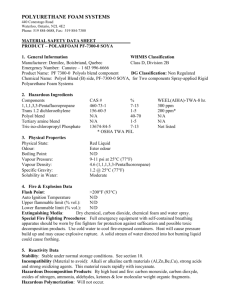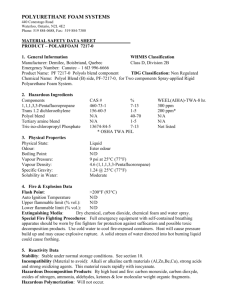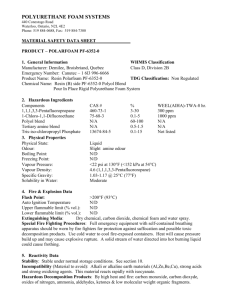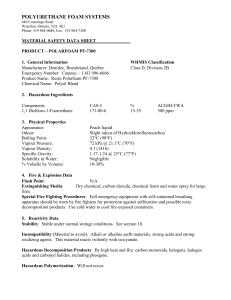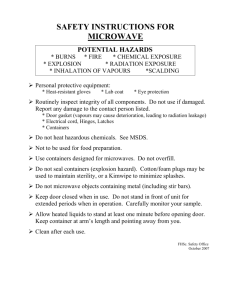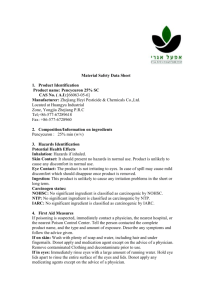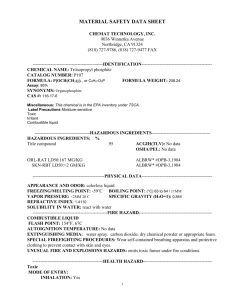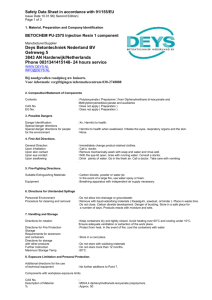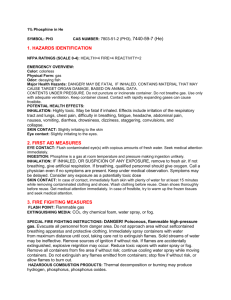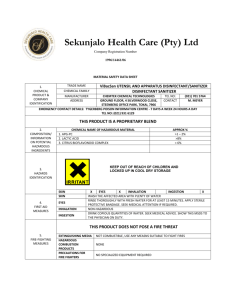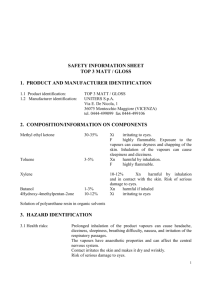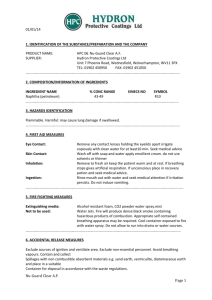POLYURETHANE FOAM SYSTEMS
advertisement
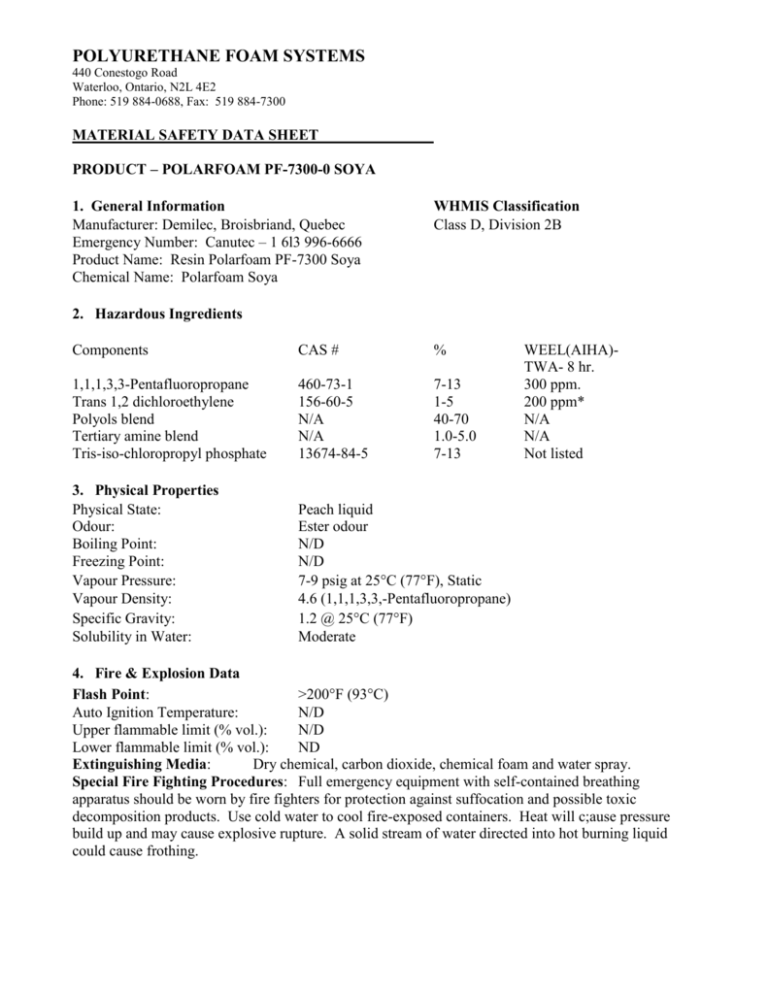
POLYURETHANE FOAM SYSTEMS 440 Conestogo Road Waterloo, Ontario, N2L 4E2 Phone: 519 884-0688, Fax: 519 884-7300 MATERIAL SAFETY DATA SHEET PRODUCT – POLARFOAM PF-7300-0 SOYA 1. General Information Manufacturer: Demilec, Broisbriand, Quebec Emergency Number: Canutec – 1 6l3 996-6666 Product Name: Resin Polarfoam PF-7300 Soya Chemical Name: Polarfoam Soya WHMIS Classification Class D, Division 2B 2. Hazardous Ingredients Components CAS # % 1,1,1,3,3-Pentafluoropropane Trans 1,2 dichloroethylene Polyols blend Tertiary amine blend Tris-iso-chloropropyl phosphate 460-73-1 156-60-5 N/A N/A 13674-84-5 7-13 1-5 40-70 1.0-5.0 7-13 3. Physical Properties Physical State: Odour: Boiling Point: Freezing Point: Vapour Pressure: Vapour Density: Specific Gravity: Solubility in Water: Peach liquid Ester odour N/D N/D 7-9 psig at 25°C (77°F), Static 4.6 (1,1,1,3,3,-Pentafluoropropane) 1.2 @ 25°C (77°F) Moderate WEEL(AIHA)TWA- 8 hr. 300 ppm. 200 ppm* N/A N/A Not listed 4. Fire & Explosion Data Flash Point: >200°F (93°C) Auto Ignition Temperature: N/D Upper flammable limit (% vol.): N/D Lower flammable limit (% vol.): ND Extinguishing Media: Dry chemical, carbon dioxide, chemical foam and water spray. Special Fire Fighting Procedures: Full emergency equipment with self-contained breathing apparatus should be worn by fire fighters for protection against suffocation and possible toxic decomposition products. Use cold water to cool fire-exposed containers. Heat will c;ause pressure build up and may cause explosive rupture. A solid stream of water directed into hot burning liquid could cause frothing. 5. Reactivity Data Stability: Stable under normal storage conditions. See section 10. Incompatibility (Material to avoid): Alkali or alkaline earth materials, (A1,Zn,Be,Cu), strong acids and strong oxidizing agents. This material reacts rapidly with isocyanate. Hazardous Decomposition Products: By high heat and fire: carbon monoxide, carbon dioxide, oxides of nitrogen, ammonia, aldehydes, ketones & low molecular weight organic fragments. Hazardous Polymerization: Will not occur. 6. Health Hazard Data Eye Contact: Product liquids, aerosols or vapours are irritating. Vapours may cause a transient condition known as glaucopsia, resulting in a blurring of vision against a bluish haze and the appearance of halos around bright objects. Skin Contact: May cause moderate irritation, defatting and dermatitis. May cause allergic skin reaction. Ingestion: May cause nausea, abdominal pains, vomiting and diarrhea. May also cause irritation to throat, esophagus and stomach. Inhalation: At high concentrations, fluorocarbons can lead to light-headedness, giddiness, shortness of breath and possible narcosis. There have been reports that exposure to high concentrations of fluorocarbons may include cardiac arrhythmia in some individuals. Vapourization of excessive amounts of the fluorocarbon components can delete or replace oxygen necessary for breathing. Excessive inhalation of vapours can cause respiration irritation, dizziness, headache, nausea and asphyxiation. 7. First Aid Procedures Eye Contact: Flush with running water for at least 15 minutes, holding eyelids open. Obtain medical attention. Skin Contact: Remove contaminated clothing. Wash affected areas with soap and water for at least 15 minutes. Wash contaminated clothing before reuse. Ingestion: Obtain immediate medical attention from physician. Treat any ill effects symptomatically and supportively. Inhalation: Remove patient to an area free from further exposure, fresh air. Administer artificial respiration if not breathing. If breathing is difficult, give oxygen. Obtain immediate medical attention. 8. Spill or Leak Procedures Action to take for Spills/Leaks: Ventilate. Eliminate all sources of ignition. Utilize recommended protective clothing. Dike area to avoid spreading. Absorb with sawdust, vermiculite or other absorbent material. Collect and contain in suitable containers. Clean-Up: Wash down surfaces with soap and warm water. Waste Disposal: Dispose of waste according to federal, provincial and local regulations. Empty containers must be handled with care due to product residue. Do not heat or cut empty containers with electric or gas torch. Polarfoam PF-7300-0 Soya, MSDS, Page 2 9. Handling Precautions Eye Protection: Use liquid chemical goggles. Eyewash fountain and emergency shower should be in close proximity. Skin Protection: Use protective clothing impervious to chemicals. Selection of specific items such as gloves (butyl or nitrile rubber), boots or apron will depend on operation. Practice good hygiene, wash hands thoroughly before handling any food. Respiratory Protection: An air-supplied respirator should be worn during liquid atomization and when the product is being heated or in environments of high concentrations above the TLV. Ventilation: Ventilation is necessary during processing. Local exhaust should be used to maintain levels below the TWA-8hr. If it is not, an air-supplied respirator should be worn by all the people located in the atomization area.. 10. Storage and Handling Storage Temperature (Min.-Max.): 15 - 25°C (59-77°F). Precaution to be taken in Storage and Handling: Store in tightly closed containers in a cool, dry place. This product is hygroscopic. Avoid breathing vapours and contact with eyes or skin. Use only with adequate ventilation. Employee education and training are important. Maintain good personal hygiene. 11. Shipping Data Technical Shipping Name: T.D.G. Classification: IMO IATA/ICAO CLASS Polyol blend, Polarfoam PF-7300-0 Soya Non-regulated Non-regulated Non-regulated 12. Regulatory Information All ingredients are listed on the DSL (Domestic Substance List) 13. Preparation By: Demilec Inc. Date: May 10, 2006 Polarfoam PF-7300-0 Soya, MSDS Page 3
